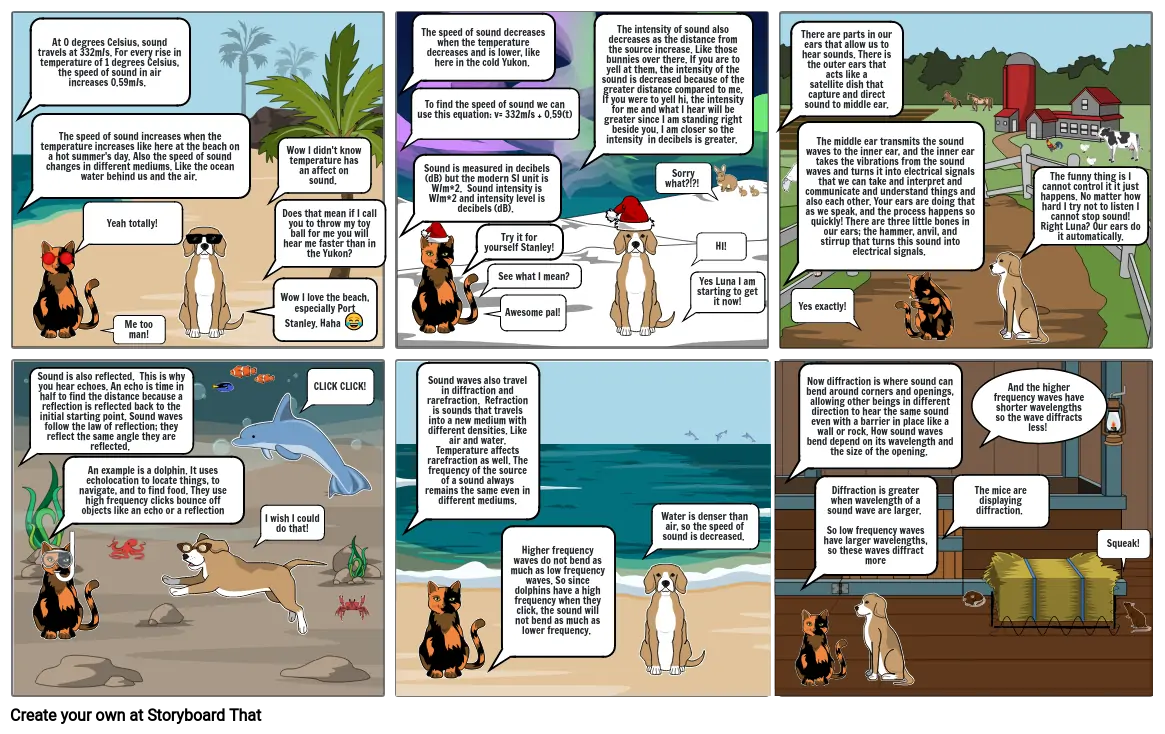Alanna De Boer Physics: Chapter 7 Comic Strip Assignment Page 2

Storyboard Text
- At 0 degrees Celsius, sound travels at 332m/s. For every rise in temperature of 1 degrees Celsius, the speed of sound in air increases 0.59m/s.
- The speed of sound increases when the temperature increases like here at the beach on a hot summer's day. Also the speed of sound changes in different mediums. Like the ocean water behind us and the air.
- Yeah totally!
- Me too man!
- Wow I love the beach, especially Port Stanley. Haha 😂
- Does that mean if I call you to throw my toy ball for me you will hear me faster than in the Yukon?
- Wow I didn't know temperature has an affect on sound.
- The speed of sound decreases when the temperature decreases and is lower, like here in the cold Yukon.
- Sound is measured in decibels (dB) but the modern SI unit is W/m*2. Sound intensity is W/m*2 and intensity level is decibels (dB).
- To find the speed of sound we can use this equation: v= 332m/s + 0.59(t)
- Try it for yourself Stanley!
- See what I mean?
- Awesome pal!
- The intensity of sound also decreases as the distance from the source increase. Like those bunnies over there. If you are to yell at them, the intensity of the sound is decreased because of the greater distance compared to me. If you were to yell hi, the intensity for me and what I hear will be greater since I am standing right beside you. I am closer so the intensity in decibels is greater.
- Sorry what?!?!
- Yes Luna I am starting to get it now!
- HI!
- There are parts in our ears that allow us to hear sounds. There is the outer ears that acts like a satellite dish that capture and direct sound to middle ear.
- The middle ear transmits the sound waves to the inner ear, and the inner ear takes the vibrations from the sound waves and turns it into electrical signals that we can take and interpret and communicate and understand things and also each other. Your ears are doing that as we speak, and the process happens so quickly! There are three little bones in our ears; the hammer, anvil, and stirrup that turns this sound into electrical signals.
- Yes exactly!
- The funny thing is I cannot control it it just happens. No matter how hard I try not to listen I cannot stop sound! Right Luna? Our ears do it automatically.
- Sound is also reflected. This is why you hear echoes. An echo is time in half to find the distance because a reflection is reflected back to the initial starting point. Sound waves follow the law of reflection; they reflect the same angle they are reflected.
- An example is a dolphin. It uses echolocation to locate things, to navigate, and to find food. They use high frequency clicks bounce off objects like an echo or a reflection
- I wish I could do that!
- CLICK CLICK!
- Sound waves also travel in diffraction and rarefraction. Refraction is sounds that travels into a new medium with different densities. Like air and water. Temperature affects rarefraction as well. The frequency of the source of a sound always remains the same even in different mediums.
- Higher frequency waves do not bend as much as low frequency waves. So since dolphins have a high frequency when they click, the sound will not bend as much as lower frequency.
- Water is denser than air, so the speed of sound is decreased.
- Now diffraction is where sound can bend around corners and openings, allowing other beings in different direction to hear the same sound even with a barrier in place like a wall or rock. How sound waves bend depend on its wavelength and the size of the opening.
- Diffraction is greater when wavelength of a sound wave are larger. So low frequency waves have larger wavelengths, so these waves diffract more
- The mice are displaying diffraction.
- And the higher frequency waves have shorter wavelengths so the wave diffracts less!
- Squeak!
Over 30 Million Storyboards Created

